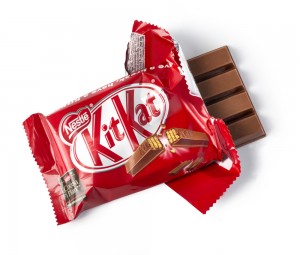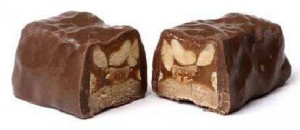 In late 2013 we wrote about a trademark dispute between the Hershey Company and Mars Inc. over whether Mars had trademark rights in the cross-section of its Snickers candy bar. Hershey opposed the mark on grounds that it was merely descriptive, de jure functional, generic, and failed to function as a trademark.
In late 2013 we wrote about a trademark dispute between the Hershey Company and Mars Inc. over whether Mars had trademark rights in the cross-section of its Snickers candy bar. Hershey opposed the mark on grounds that it was merely descriptive, de jure functional, generic, and failed to function as a trademark.
The cross-section of Snickers, according to Hershey, was no more distinctive than the cross-section of other candy bars such as Oh Henry!, Baby Ruth, and Peanut Chews.

OH Henry
We wrote that that this was “a great example of the interaction between aggressive branding, trademark law, and competitive forces.” So, what happened to this sweet trademark dispute? Nothing! Since the case was filed, the Appeal Board’s docket shows a series of routinely granted motions for an extension.
Recent events in the UK suggests that Hershey may have the upper hand in its dispute with Mars. In 2010, Nestlé attempted to register the shape of its KitKat candy bar in the UK. Cadbury chocolates opposed the registration on grounds that the shape of the candy bar was insufficiently distinctive to warrant a trademark registration. The European Court of Justice concluded that Nestlé’s trademark application did not comply with European law. In a 2014 written opinion, the judge said that Nestlé had not used the candy bar’s shape in promoting it and, in fact, packaged it in opaque wrapping that hid the allegedly distinctive shape. So, this means that consumers identified the source of the chocolate bar not by its shape but by the written trademark written on the candy’s wrapper. The judge wrote that consumers may associate the shape with KitKat candy “but no more than that.” This is not to say that shape cannot distinguish a candy product. According to the Guardian, which reported the story, the shapes of the Toblerone candy bar and Nestlé’s Walnut Whip are both registered trademarks.
Under European trademark law (and under U.S. law), trademarks are deemed to be indicators of the source of goods and services. If consumers do not rely upon the product’s shape to identify the product’s source (i.e., who made it) then it would appear that the shape is not a trademark. Nestlé disagrees and it intends to appeal the European Court’s decision. The Guardian quoted a European trademark attorney:
This seems to be a commonsense decision and perhaps public policy also played a part. Allowing registration of the KitKat shape would have given Nestlé invaluable monopoly and competitive advantage over other confectionery manufacturers, which is one of the reasons why Cadbury has been keen to stop them.
If we were to apply this reasoning to the Hershey – Mars dispute reported by us in 2013, Mars could not maintain trademark rights over the cross-section of its Snickers candy bar because the cross-section is invisible to the consumer before he buys and bites into it. Let’s see what happens.
— Adam G. Garson, Esq.

